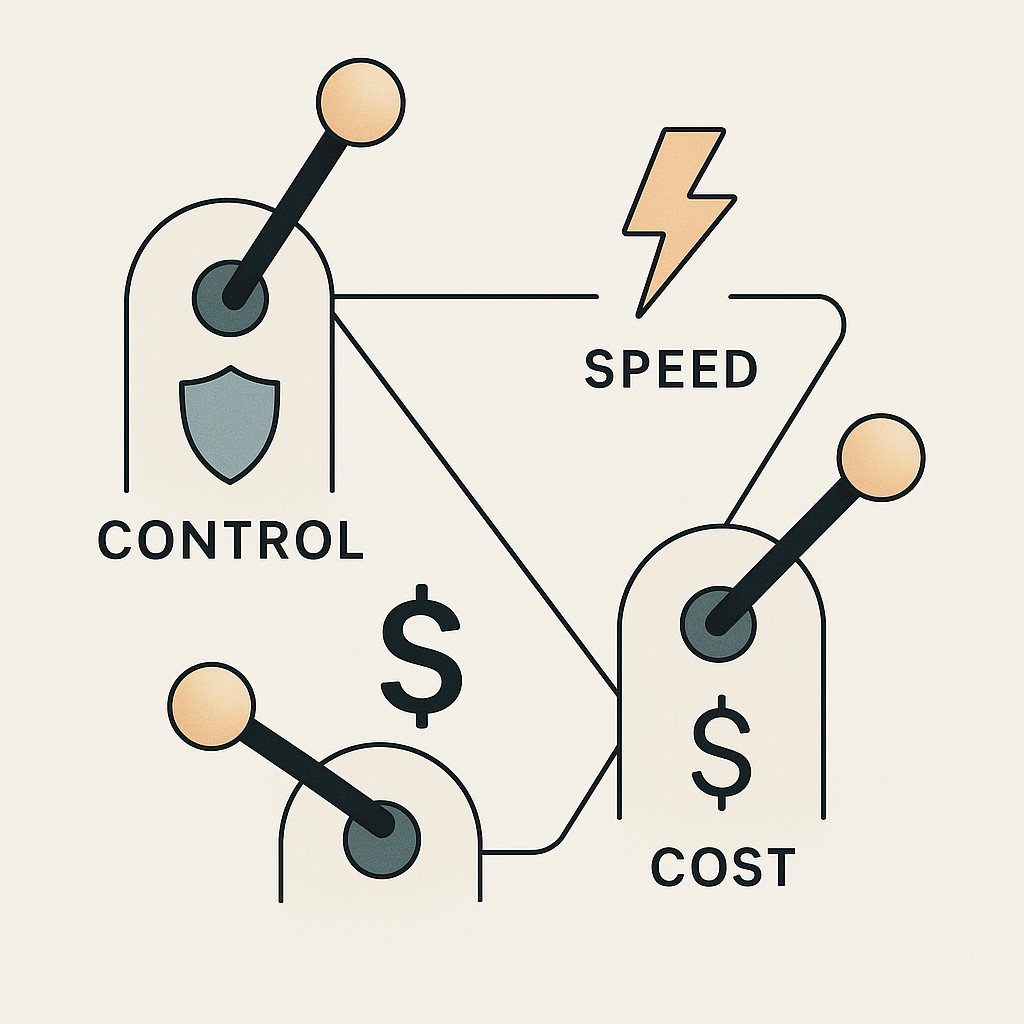Decide In-House vs Outsource: A Practical Rubric to Cut Friction and Rework
Decide In-House vs Outsource: A Practical Rubric to Cut Friction and Rework

When “Fast” Isn’t Enough: The Offshore POC That Reframed Our Outsourcing Tradeoffs
It was a classic proof-of-concept, but first we had to decide in-house vs. outsource. Validate the core interaction, get a demo ready, ship something—fast. We spun it up with an offshore partner we’d vetted over Slack calls and a handful of references. Four days in, they hit send. Code arrived zipped at 2:43am local time, functional, mostly as specified. But as we rolled through everything on day 5, it was clear something substantial got lost between sprint planning and what landed. The time zones barely overlapped—every extra hour of separation meant 11% less real-time collaboration, and friction just built up for each miscommunication or that last-minute tweak we missed in the sliver of overlap (synchronous overlap drops—every extra hour between teams means 11% less real-time collaboration, compounding friction on the ground).
Nothing broke, but those rough edges—like variable naming that made sense only in isolation, or a flow that fell apart with just one real-world constraint—landed the review back in our laps, with another swollen email thread trying to untangle what we even meant. Getting something “done” this fast can work, but only if you’re honest about what you lose in the translation.
I’ve tried outsourcing. A lot. The stories pile up—sometimes wins, sometimes messes I’d rather not recall if we’re being honest.
Here’s the real recurring theme. Communication always suffers when you have to “pass the baton” instead of working side by side. Short-term external teams rarely get enough runway to dig into your domain context, which just leaves gaps in their core understanding (which leaves gaps in core understanding). Domain knowledge? Lacking. We’re not blaming vendors—it’s just hard physics, how much context you can realistically ship across time zones and contract lines.
So let’s not kid ourselves. Outsourcing isn’t “good” or “bad”—it’s a tradeoff. This post is mostly about showing the practical markers, and giving you a framework you can carry into your next backlog review.
The Three-Lever Tradeoff: You Can’t Maximize Everything at Once
Every decision to outsource comes down to three levers: ownership and control, iteration speed, and flexibility or cost. You push one up and the others pull back. If you keep work in-house, you’re close to the code and the users, able to steer and tune as you go. That buys control, and deeper context, but you’ll move slower—and it’s almost always pricier.
Outsourcing shifts the needle toward flexibility and cost. External teams can spin up fast, plug skill gaps, and scale down when you want out. But you lose some say in how things get done, and you’re on the hook to spell out instructions if you hope for anything resembling what you planned. Speed? Sometimes you ship prototypes quickly, but grainy context and slow feedback loops mean real outcomes slow down as edge cases kick in.

Trying to maximize all three levers—control, speed, and cost—breaks down fast because these are the outsourcing tradeoffs in tech. We tried. We watched dependencies leak, review cycles stretch into overnight ping-pong, pipelines jam up fixing things we hadn’t spelled out. The hidden bill shows up in hours spent “clarifying” what should’ve been clear at the kickoff. You don’t just lose time—you lose the team’s energy, chipped away by reruns of the same conversation.
Honestly, the part nobody wants to say out loud: most of the time if requirements are fuzzy or change midstream, it’s our mess. No matter how strong the vendor is. “They didn’t get it” almost always means “we didn’t specify it.” The real cost isn’t just money—it’s trust and momentum lost up and down the line.
Six months ago, I thought we could finesse these tradeoffs by writing longer specs. Turns out, no spec is long enough if the context behind it keeps shifting. The rest of this playbook is about tuning those dials so you choose your tradeoffs, instead of being surprised after the fact.
Turning Tradeoffs Into a Playable Decision Rubric to Decide In-House vs. Outsource
At the end of another sprint planning session—too many tasks, constantly not enough time—you’re staring down the familiar backlog swamp. You want to ship faster, with less churn, but you know what happens when you hand off context-heavy work. Now, instead of a fire drill, there’s a way to slice the pile into two buckets: keep in-house vs. outsource. The goal is (honestly) simple: match type of work to execution mode so you get more real progress and less circling back. If you pick right, planning gets easier and outcomes cleaner.
Let’s take the in-house bucket. When you weigh whether to outsource or build in-house, anything with tangled dependencies or moving parts you can’t really write down belongs with your in-house team. If the task touches your core user experience, or requirements could mutate after first release, keep it close. Signals look like this: daily tweaks, high strategic impact, or needing domain context built up over months. Classic examples? Auth flows, platform-critical APIs, or UX experiments.
If there are tricky upstream or downstream hangups, or the task feels like it’ll morph as you dig in, that’s home turf. You’ll iterate fast and catch edge cases because the feedback is direct. Learned the hard way—“simple” features get complicated quick when they touch anything strategic or need deep product intuition. Give those to your own team. They won’t regret it.
What goes in the outsource bucket? Think outsourcing non-core tasks: work that’s well-defined, not unique to your business, or all about cost and speed. If you can document requirements precisely, deliverables won’t shift much, and someone with targeted expertise fills a gap you don’t have time for, outsource it. Skill gaps and velocity drive outsourcing—59% seek specialized expertise, and 57% use it to reduce time-to-market.
We’ve outsourced quick proof-of-concepts when we needed to validate without burning long-term resources. Stuff like SaaS integrations, “lift and shift” migrations, or well-scoped utility scripts belong here—as long as the spec is solid. The key: the handoff works when instructions survive translation and tight feedback. If clarity shakes or the external team needs to absorb five years of product quirks, hit pause. If you can package the work into a tight deliverable, risk stays low. Outsourcing isn’t easy. It’s just safer when the signals line up.
To actually use this, grab a note or spreadsheet and run tasks through a simple checklist: Does it need deep context? Do requirements change quickly? Strategic outcome, or peripheral? Can you write an airtight spec? Sensitive to budget or delivery cost? If a task is high on context, fast iteration, and strategic impact, keep it. High on clarity and cost? Outsource.
In-house vs outsourcing decisions aren’t all that different from DIY vs. hiring a pro at home. If it’s mission-critical, or you know it could blow up, you just get hands-on. If it’s clear-cut, bring in help. The rubric is mostly there to keep you from arguing, so you deal in realities instead of hunches.
Making the Rubric Work: Briefing, Staffing, and Guardrails for Both Tracks
Start every task—doesn’t matter if it’s outsourced or in-house—by wiping out ambiguity. Map the owner (who takes heat if deadlines wobble), clear scope (don’t let “maybe” features creep in), straightforward acceptance criteria (so review doesn’t get looped into endless “did we mean this?” email strings), a simple decision log (track why you made each call, not just what you picked), and explicit integration boundaries (define where interfaces hand off, so nobody gets floored by surprises upstream). Sketching these out up front pays off fast; output stabilized once framing cut down the back-and-forth cycle that used to steal days from us just clarifying “done.”
Time zones sneak up more than you expect on paper. That offshore POC? We never really clocked how little overlap we had—each lost hour meant one less chance to catch something before it snowballed. Set overlap hours up front if you can, but build for async, make every decision visible in writing. If questions are stuck waiting overnight replies, everything drags.
If you need clear specs, docs, or updates without burning cycles, use our AI-powered app to generate polished content fast and keep your team focused on core engineering work.
Set milestones with care, not just for the project plan. Early check-ins—wireframes, API stubs, barebones contracts—surface drift before you’re out of range to steer. By day 5, do a live sync with the whole crew: walk through what’s built, call out anything off from “those variable names don’t add up” to “this doesn’t match the flow we mapped.” That quick ritual saves from week-long detours.
Protect your core team’s bandwidth by thinking in terms of engineering resource allocation. Offload grunt work—data migration, writing boilerplate, bug bashing—so your engineers can focus on the stuff that actually pushes the business. Giving the external team operational tasks didn’t just help our burn cost. It kept our folks on learning-rich bets instead of burning out on endless rounds of refactoring.
Don’t let risk pile up quietly. Bake in guardrails: limited-scope pilots before scaling, service-level objectives, non-negotiable code and security reviews, and baseline documentation of outcomes. Keep a kill switch ready—if a vendor fit crumbles (missed SLOs, weird code, gaps you can’t close), cut loose sooner, before sunk costs. Each control keeps mistakes visible and fixable, not buried until launch.
All these steps are less about dodging errors and more about catching and fixing them before you end up spinning months on rework. If you map the process up front, backstop it with live feedback, and use hard boundaries, you tilt the odds in your favor. The trick is staying disciplined when it’s crunch time. We don’t always nail this—a couple cycles ago, we got sloppy on requirements, and it’s still biting us.
Anticipating Pushback: Time, Control, and Building Trust With the Rubric
If investing upfront energy in this setup feels like overkill, we get it. The work is real. But spend an hour now and you’ll save ten more lost to task churn and ownership fog. Try this: pick one backlog item and actually use the rubric for your next cycle. For us, just one more “easy handoff” turned into three rounds of lost alignment—never again.
Nervous about control? Here’s the balance. Keep your core ownership in-house, but let vendors execute against clear interfaces and review gates you own. You set the keys, while they handle the repeatable bits. The angle isn’t giving up standards—it’s pairing your context with their speed.
Vendor reliability is a worry even on engagement number twenty. So start small and push for early demos; don’t hand over big chunks until you see process, not just code. Look for domain-adjacent experience; the closer their context, the faster things click. Collaborating with experienced teams taught us things we wouldn’t have learned alone. Sometimes the partnership is smooth, other times it’s pure steering—but each round sharpens your playbook.
I still wrestle with one thing. No matter how clear the rubric is, every so often I find myself second-guessing whether I should’ve kept a task at home or shipped it out. We haven’t figured out the perfect system for that. The tension sticks around, but the playbook at least forces the decision out into the open, instead of letting it fester under layers of wishful thinking.
Don’t wait—run your next planning session through that rubric. Deliberate allocation turns fast shipping into real progress, without waking up to friction you never saw coming. That POC we opened with? Shipped fast, sure, but not without tradeoffs. Progress isn’t just velocity; it’s hitting the right mix, eyes open to every lever in play.
Enjoyed this post? For more insights on engineering leadership, mindful productivity, and navigating the modern workday, follow me on LinkedIn to stay inspired and join the conversation.
You can also view and comment on the original post here .
